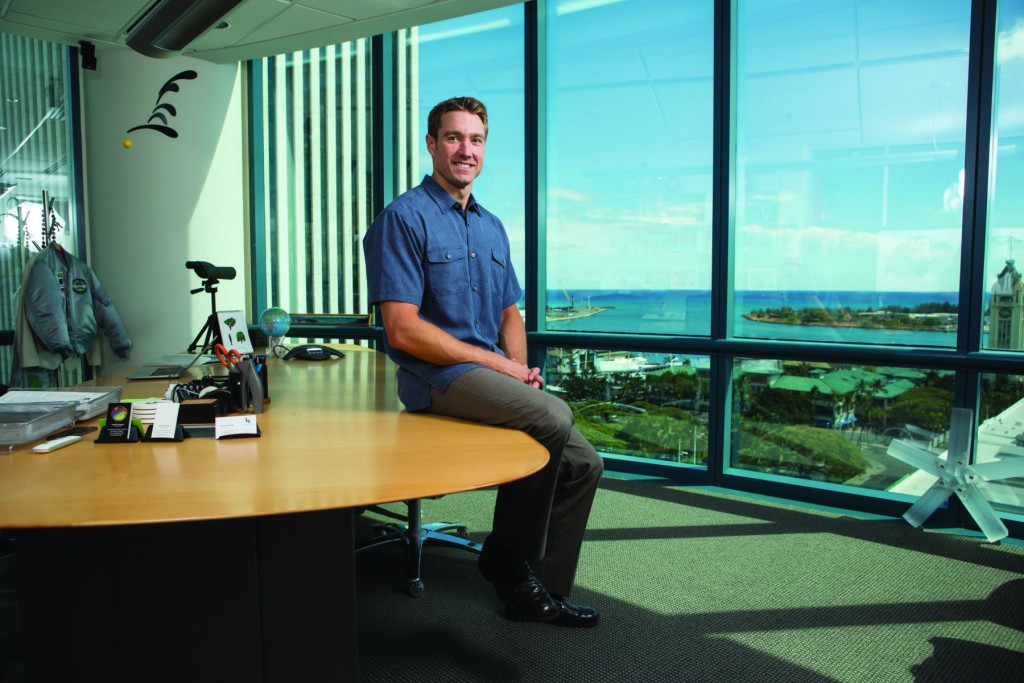Talk Story with Jeffrey Mikulina

Photography by David Croxford
In April, the state Public Utilities Commission ordered Hawaiian Electric’s utilities on Oahu, Maui and Hawaii Island to take action in four ways: “aggressively pursue energy-cost reductions, proactively respond to emerging renewable-energy-integration challenges, improve the interconnection process for customer-sited photovoltaic systems and embrace customer demand-response programs.” The PUC gave the companies until the end of August to submit plans outlining their progress toward these goals.
How does the PUC ruling affect Hawaii’s energy future?
The PUC is asking Hawaiian Electric to act very quickly. Utilities usually operate on a geologic time scale. They have huge capital infrastructure that lasts a long time and they’re risk averse. So when the PUC says 120 days to turn it in, that’s fast.
This is driven by two factors: disruptive, rapid technology change and customer choice. That second driver has emerged in the last half-decade on rooftops all over the state. People took power into their own hands and reduced their energy bills. In the future, those two drivers will show up in lots of places. The PUC is saying: “If we just let these two drivers happen, it could have negative outcomes, so let’s manage this properly.”
What changes are coming?
The new system will be more participatory. The system of the last century was one way, where electricity came in and you paid for it. In the new system, the utility is less of a provider and more like an energy concierge.
Each customer should have options. Some will choose cheap energy, some will want 100-percent reliable energy and others will want 100-percent green energy. The utility will provide those services.
For instance, the customer might have an electric vehicle, a Leaf, and say, “I want to charge the Leaf when electricity costs under 20 cents an hour and sell it back when it’s over 40 cents, while making sure I can always drive 50 miles.” This would require new time-of-use rates.
What that finally recognizes is not every electron is created equally. When you do that you create a more equitable, representative electricity market.
How do you balance supply and demand?
In building a system of 100-percent renewable energy, we must control the load and supply in order to be more efficient. There are a lot of ways to do this. For instance, do you want to let the electric company reach into your home and turn things off and on? There are small devices that turn off your water heater for 10 minutes at a time to reduce demand on the grid when needed. If a customer participates, can they see reductions in cost? Hawaiian Electric has been doing it on a small scale, but not the scale we need.
Some people might say, “No way, I want power 100 percent of the time and don’t touch my stuff.” Those people will probably pay a little extra. Others might want to participate in turning off the load where they can.
A third customer might be super participatory and say, “I want solar, batteries, electric vehicles and give me a whole menu of options. For instance, maybe you can draw power from the battery in my car on cloudy days, or turn my appliances on or off behind the scenes without me knowing.”
Creating a modern two-way grid will cost a lot of money. What’s the incentive for a for-profit company like Hawaiian Electric to make those investments?
It will be expensive to modernize the electricity grid so it can accommodate distributed renewable energy and balance supply and demand. But it is in Hawaiian Electric’s best interest to do so for a variety of reasons. The short answer is investing in the modern grid expands Hawaiian Electric’s central role as an integrator and provider of energy services – a key position for Hawaii’s renewable, efficient, and customer-centered future.
In the longer analysis and, thinking traditionally, the utility is generally allowed to recover its investment plus a return for such needed capital expenditures (under Hawaii’s decoupling regulation). Some form of this arrangement will likely continue, although the PUC is currently reviewing the process through which the utility is allowed to make a return. Part of the impetus driving the review is a measure enacted by the Legislature last year (Act 37) that directed the PUC to consider alternative incentive mechanisms that would encourage preferred utility investments.
The bill said, in part: “The Legislature additionally finds that the current electric-ratemaking process employs a single authorized rate of return that is applied equally to all utility plant investments. This methodology does not differentiate between plant investments to modernize the electric grid, which should be encouraged, and investments to preserve old, inefficient fossil generation, which should be discouraged.”
But, thinking nontraditionally, the utility’s investment in the modern grid provides them with an asset that enables them to diversify and potentially participate in new revenue streams. Over the past four years, a new solar power plant was added to a rooftop in Hawaii every hour. And residents and businesses are starting to use less electricity per capita. So the utility would be wise to invest in infrastructure to enable this evolution of customer choice – providing new value to their customers while they profit.
The bottom line is the utility needs to pivot from selling a commodity (electrons) to providing infrastructure for services. If they fail to do this in a meaningful way that provides real value to customers, those customers will naturally choose more attractive alternatives.
What’s the role of bigger electricity projects?
Things like planned micro-grids on Lanai and at Parker Ranch and already created micro-grids at military installations like Camp Smith are leading the way. They recognize that, if something happens, they have to keep the lights on. They’re fully functional grids, so they can stand alone, but are also fully attached to Hawaiian Electric. It’s like the Internet with servers in different places. If we lose one piece we can always rely on another.
For its micro-grid, Parker Ranch is talking about wind, solar and storage. The direction from the utility should be, “That’s great! What can we do for you?” We’re stronger together and if that customer leaves, you lose the opportunity to share resources.
Today, we also need the large wind, the large solar farms. They’re much more cost effective and we’d like to see more. Also, more geothermal on the Big Island. We might also be seeing more wave energy or ocean conversion. There’s going to be a major role for large utility-scale projects complemented by distributed energy that customers install themselves. We have to build this system to accommodate both. That’s going to be HECO’s kuleana – to figure out what the system looks like and how do we enable democratization of energy and clean energy to plug into the grid.
What do you see as the future of battery storage for powering homes?
With all the research, energy storage is coming. As a technology, it’s where solar was 10 years ago. We just don’t know what it looks like yet.
The utility went out for a request for proposals just a few weeks ago for energy storage. That’s exciting. They’re looking for lots of it, capable of storing 60 to 200 megawatts for up to 30 minutes. It’s still really expensive and out of reach for most people, but what will we see in the next five years?
Any significant developments at the Legislature?
This was a really unfortunate year for energy. The recent PUC decision shows their rightful impatience with the rate of change. The utility is behind, but the Legislature has been out to lunch. They’re missing opportunities to do important things.
The biggest loss was this community solar program. Right now, half the state can’t participate in solar because they don’t have a roof. The idea is we have all these people who live in condos, or have trees shading their roofs, where they can’t do solar. So why can’t they hui up and have their solar somewhere else? It’s the same concept as community gardens. Your solar panel could be on an empty warehouse rooftop and you pay for that solar installation and get the tax credits for it.
Senate Bill 2934 was another initiative, a tax credit for energy storage. It’s a key piece of the future that did not pass. Also, another bill that had HECO support was to require Hawaii to produce 100 percent of renewable energy by 2050, but it didn’t pass.
Today, we have some incremental goals, including 40-percent renewable energy by 2030, but we need to have the end-goal in place. As long as we know we’re heading toward 100 percent, we’d get a lot more buy-in from folks and support for the utility. When we get to 100 percent, we no longer have to worry about the price of oil, or EPA regulations, or pollution, or contributing to climate change. That will be a whole new world. The price of electricity will be set.
This interview has been edited for conciseness and clarity.






